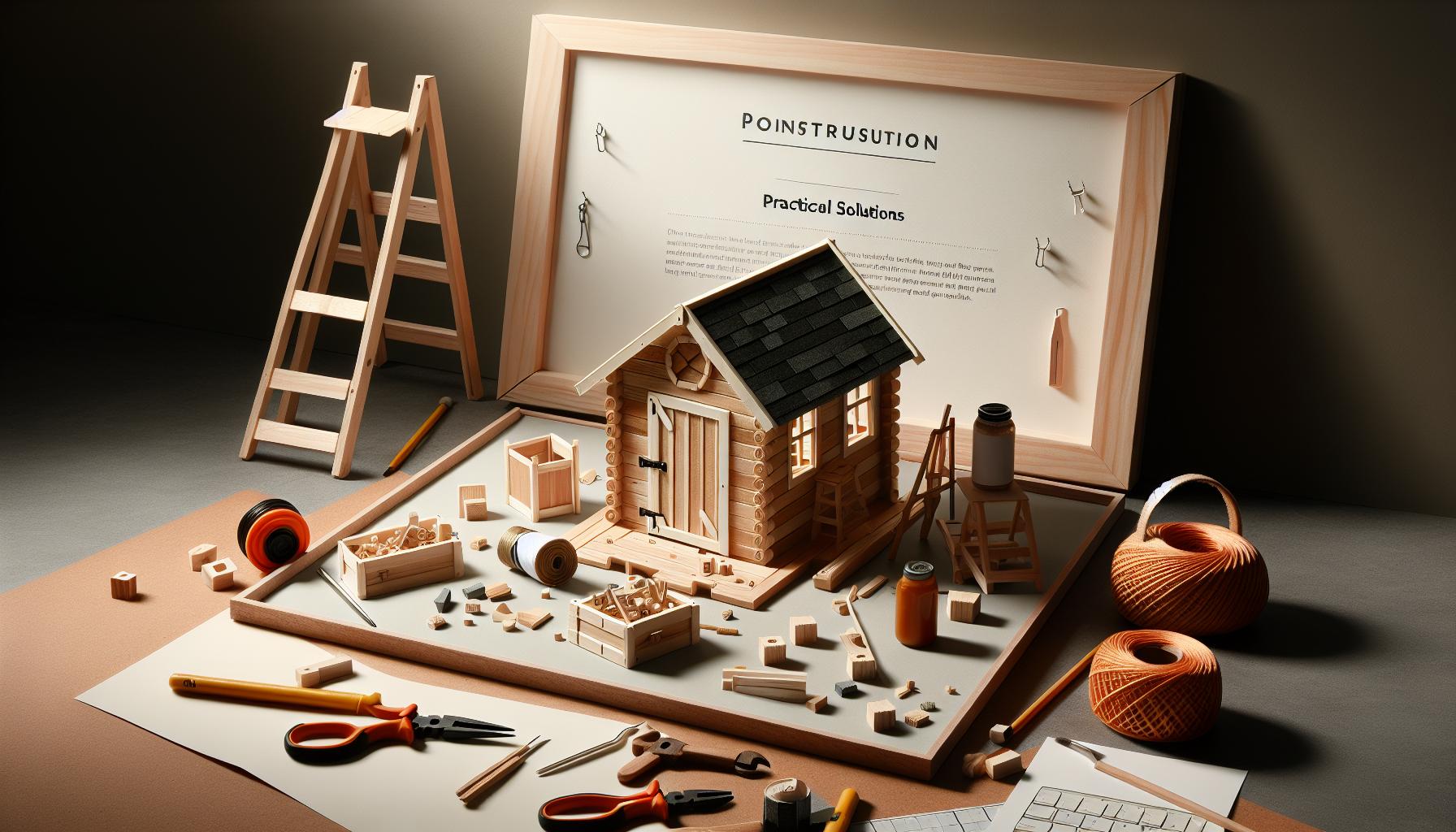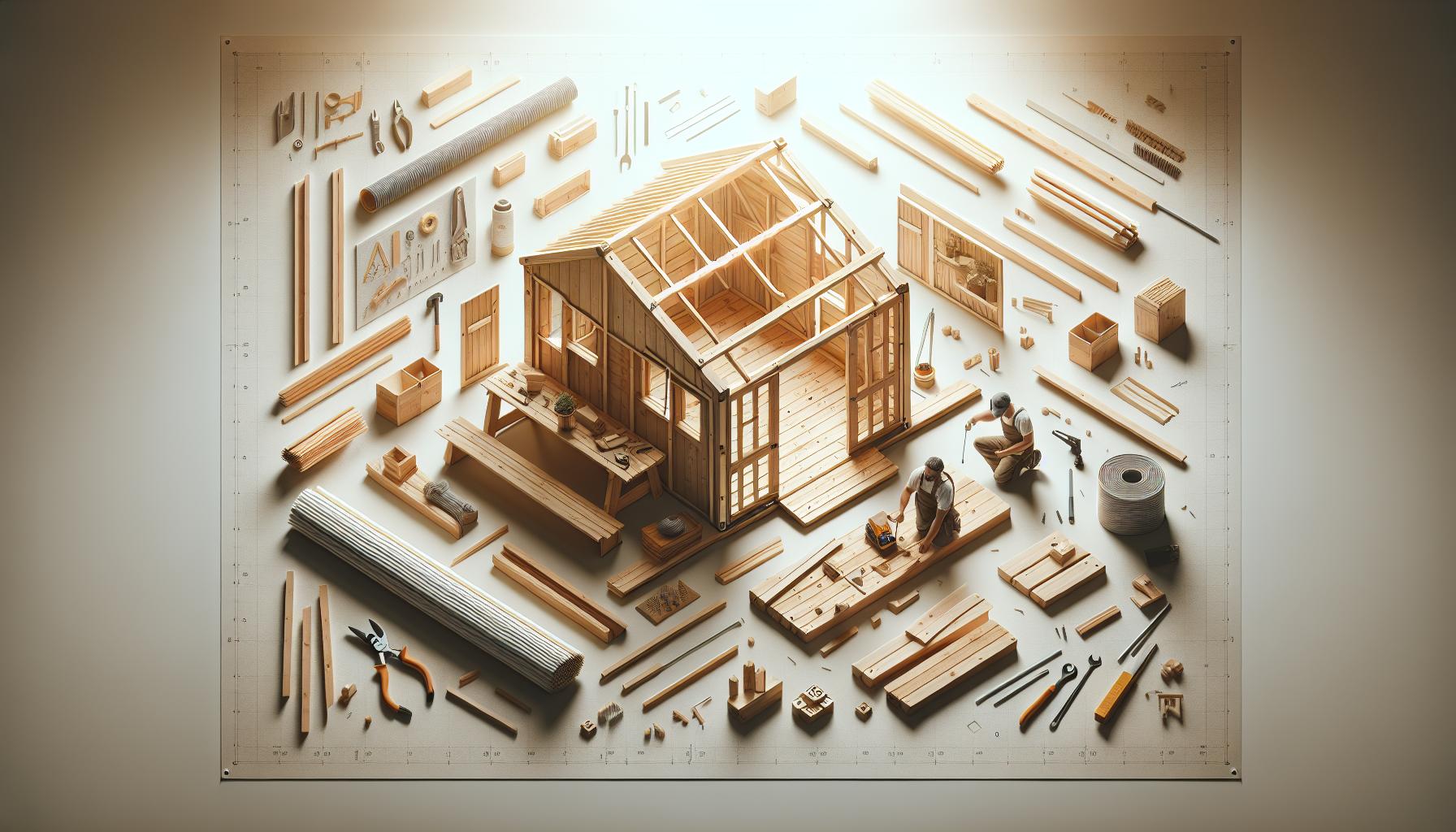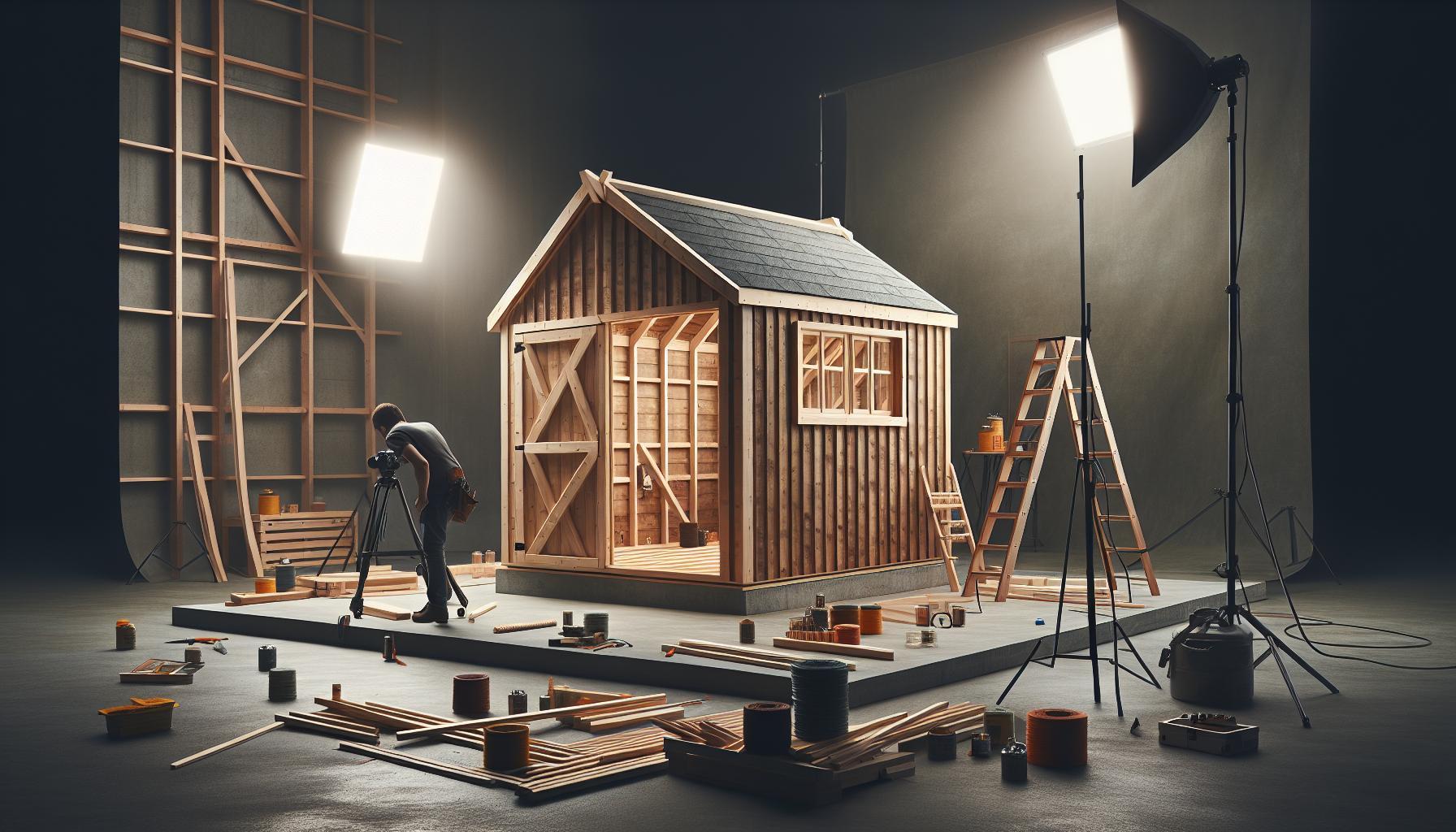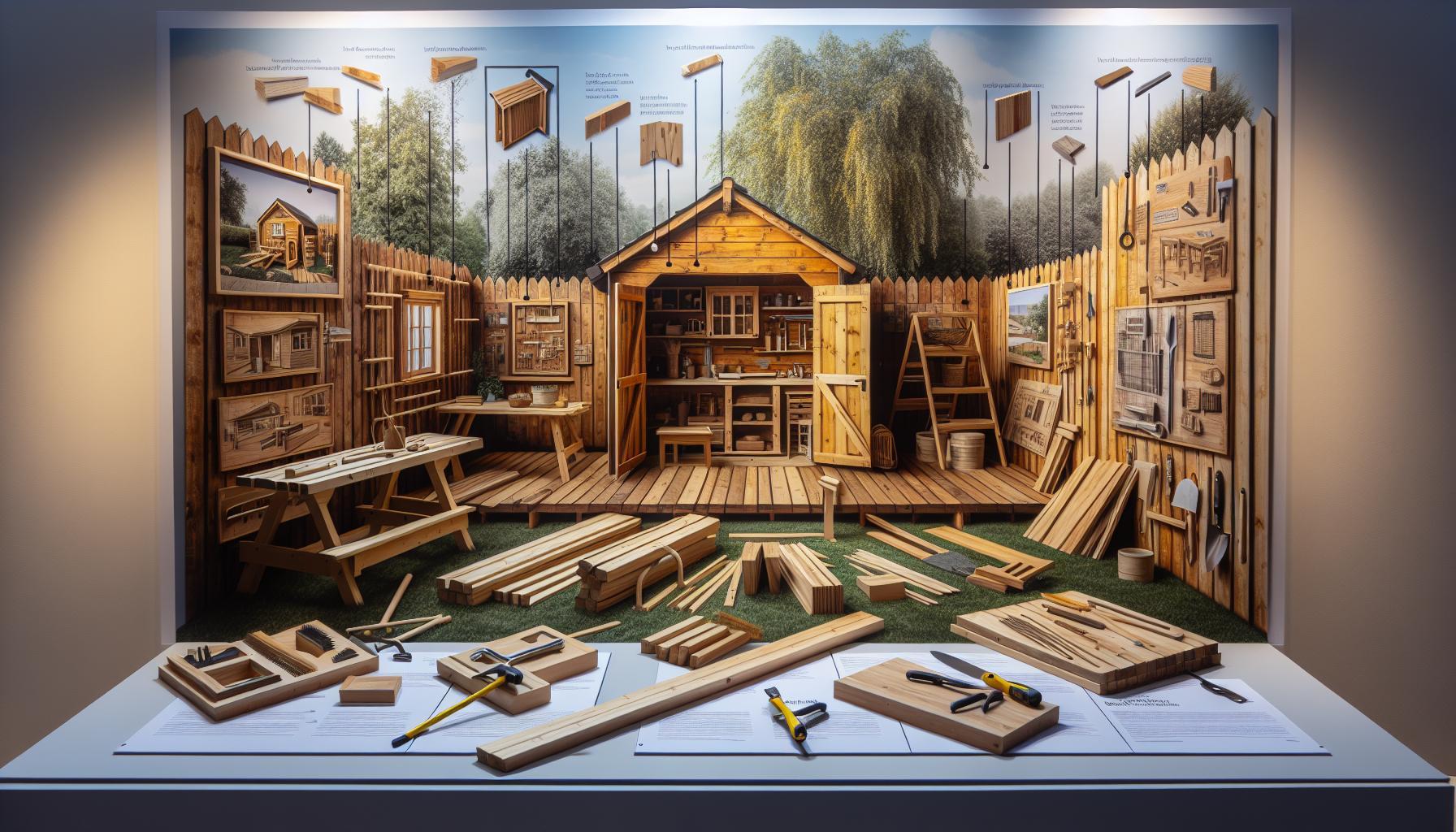As our needs evolve and space constraints arise, finding adaptable storage solutions becomes essential. Building a portable shed offers flexibility for organizing tools or equipment, ensuring you have the right space when you need it. Embrace the opportunity too create a functional, mobile structure that can transform how you manage your outdoor areas efficiently.
Understanding the Benefits of a Portable Shed for Your Lifestyle
Imagine having extra space that can adapt to your changing needs at a moment’s notice. A portable shed offers just that, providing homeowners an innovative solution for storage, workspace, and more, all while maintaining the flexibility of mobility. With the rising demand for versatile living and working spaces, understanding the benefits of incorporating a portable shed into your lifestyle is essential.
Versatility and Adaptability
Portable sheds are designed to be flexible and can serve various functions. Weather you need a craft room, a gardening shed, or a small workshop, these structures can be customized to fit your specific lifestyle needs. Their adaptability is particularly beneficial for those who live in urban areas with limited space or for families that may require extra room at different times of the year. For example,during the summer months,a portable shed could serve as a play area for children,while in winter,it could be transformed into a cozy retreat for hobbies.
Cost-Efficiency and Accessibility
Investing in a portable shed can be economically favorable compared to permanent structures.Many portable sheds are less expensive to purchase and install, which is particularly appealing for those on a budget. Additionally, because they typically do not require building permits, you can save time and money that would otherwise be spent on bureaucratic processes. The ability to quickly set up a portable shed means that you can have your desired space ready to use in a fraction of the time compared to traditional building methods.
Enhanced mobility
One of the standout features of portable sheds is their mobility. Unlike fixed structures,if your needs change or you decide to relocate,these sheds can easily be moved to a new location.This freedom maximizes their utility over time. For instance, in a scenario were you might want to relocate for a job or have seasonal storage needs, a portable shed allows you to take your investment with you. It’s an ideal solution for renters or those who enjoy changing their habitat.
By incorporating a portable shed into your lifestyle, you’re choosing a solution that brings flexibility, cost savings, and the convenience of mobility to your everyday life. Whether you’re looking to optimize your space or want a versatile area for your interests, understanding how to build a portable shed can lead to significant lifestyle improvements.
Choosing the Right Materials for Durability and Mobility
When embarking on the journey of constructing a portable shed, selecting the right materials is crucial for ensuring both durability and mobility. The combination of these two attributes can greatly affect the shed’s longevity and its ease of relocation. Choosing materials that withstand the elements while remaining lightweight allows for efficient movement and utility. For instance, utilizing galvanized steel for the frame can provide a robustness that resists rust and wear, enhancing the shed’s lifespan.
Essential Materials for Durability
To maximize durability, consider the following materials:
- Plywood: Use marine-grade plywood for the floor and walls to resist moisture and prevent decay.
- steel components: Incorporate galvanized or powder-coated metal for brackets and connectors, which protects them from corrosion.
- Quality Roof Material: Invest in asphalt shingles or metal roofing which can withstand harsh weather conditions and reduce maintenance needs.
Enhancing Mobility with Lightweight Materials
mobility is just as important, especially if relocation is part of your plans for the portable shed. Here are tips to ensure your shed remains easy to move:
- Choose Lightweight Frames: Aluminum or lightweight steel options for the frame can significantly reduce the overall weight without sacrificing strength.
- Modular Design: Opt for a design that allows for disassembly, making it easier to transport individual components.
- Portable Foundation: Consider using skids made of treated lumber or plastic that allow the shed to be moved easily without damaging the ground.
Each of these elements plays a vital role in the overall functionality of a portable shed. By focusing on the right mix of durable and lightweight materials, you can create a structure that not only stands the test of time but can also adapt to your changing needs, ensuring that your investment in “How to Build a Portable Shed: Mobility Solutions for Changing Needs” is both sound and practical. Consider not just the weight and endurance of materials but also their availability and cost-effectiveness as you design your project.
Step-by-Step Guide to Designing Your Portable Shed
Building a portable shed can be a transformative project, allowing you to create flexible storage solutions directly suited to your specific needs. To start your journey in designing your portable shed, it’s essential to focus on practical considerations that ensure functionality while maintaining mobility. By following a structured approach, you can craft a space that is not only aesthetically pleasing but also easily relocatable.
Step 1: Define Your Purpose
Before diving into the design, clarify what you intend to use the shed for. Whether it’s for gardening tools, a workspace, or seasonal items, understanding its primary function will guide your choices in size, material, and layout. Here are some common uses to consider:
- Garden storage
- Workshop area
- Playhouse for children
- Hobby space
- Seasonal storage
Step 2: Choose the Right Location
Selecting the right site for your portable shed is critical to its usability and accessibility. Look for level ground that provides good drainage and sunlight, but also consider proximity to your home or workspace.Accessibility for moving the shed, whether through a truck or trailer, should also be at the forefront of your decision-making process.
Step 3: Plan your Design
With a clear purpose and location in mind, it’s time to sketch your shed’s design. Consider key elements such as:
| Element | Description |
|---|---|
| Size | Determine dimensions based on storage needs—common choices range from 8×10 to 12×20 feet. |
| Material | Choose between wood, metal, or resin based on durability, cost, and maintenance. |
| Layout | Include shelving, windows, and doors for optimal organization and access. |
ensure that your design allows for easy mobility. This might include incorporating skids or trailer frames into the base, enabling the shed to be towed without damaging it.
Step 4: Assemble a List of Materials
Once your design is finalized, compile a list of necessary materials. This may include:
- Plywood or OSB for the floor and walls
- 2×4 lumber for framing
- Roofing material such as shingles or metal sheeting
- paint or sealant for weatherproofing
- Hardware including screws, nails, and brackets
Gathering all materials before you begin construction will streamline the building process and minimize delays.
By carefully following these steps,you’ll be well on your way to creating a customized,portable shed that meets your changing needs,melding utility with the flexibility to adapt to your lifestyle.
Essential Tools and Equipment for Building a Mobile Shed
When embarking on the journey of constructing a mobile shed, having the right tools and equipment is paramount. The precision and efficiency these tools bring can significantly impact the quality and durability of your shed. Whether you’re looking to create a simple storage solution or a more sophisticated portable workspace,understanding the essentials can make the process smoother and more enjoyable.
Must-Have Tools for Assembly
A well-stocked toolbox will definitely ease the construction of your portable shed. Here’s a list of essential tools you should gather:
- Power Drill: Essential for drilling holes and driving screws, ensuring a sturdy build.
- Saw: A circular saw or jigsaw will help you make precise cuts in wood or other materials.
- Measuring Tape: Accuracy in measurements cannot be overstated; this tool will ensure all components fit properly.
- Level: To keep your structure level and aesthetically pleasing, a level is crucial in achieving that flat surface.
- Hammer: A basic yet indispensable tool for assembling and securing various parts together.
Materials and Supplies
Equipping yourself with the right materials is just as critically important as having the right tools. Below is a summary of the supplies you’ll need:
| Material | Purpose |
|---|---|
| Wood (Plywood or Timber) | Main structure and framing. |
| fasteners (Nails and Screws) | To hold pieces together securely. |
| Roofing Material (Metal or Shingles) | To protect against weather elements. |
| paint/Sealer | For weatherproofing and aesthetic appeal. |
By gathering these essential tools and materials, you position yourself for success. Remember, a well-planned approach tailored to your needs will ultimately yield a mobile shed that not only meets your storage requirements but also stands the test of time. As you contemplate how to build a portable shed effectively, consider these specifics to streamline your project and achieve a functional space adaptable to your changing needs.
Overcoming Common Challenges in Portable Shed Construction
requires a proactive approach and practical solutions tailored to the unique needs of mobile structures. One of the primary hurdles is ensuring structural integrity during transportation, as portable sheds face different stresses compared to stationary ones. Utilizing quality materials and reinforcing key structural elements are essential strategies. For example,opting for sturdy framing techniques and high-grade plywood can significantly enhance durability.Another challenge often encountered involves space optimization. Given the typically compact dimensions of portable sheds, maximizing functionality is crucial. This can be achieved by incorporating versatile furniture and storage solutions, such as foldable tables or wall-mounted shelves, which can minimize clutter and allow for more usable space. Consider implementing multi-purpose designs that adapt to various uses,whether for storage,a workshop,or even a guest space.
Furthermore, insulation and weatherproofing present critical considerations, particularly if the shed will be used year-round. Proper insulation not only regulates temperature but also protects against moisture-related issues. Homeowners can choose insulated panels or spray foam, both of which provide excellent thermal barriers. Additionally, investing in quality seals around windows and doors can prevent drafts and leaks, enhancing energy efficiency.
Lastly, understanding local zoning regulations and obtaining necessary permits can pose challenges for portable shed owners. Before construction, it’s advisable to consult local building codes to avoid potential legal complications. This planning ensures smooth installation and future mobility, aligning with the principles outlined in ‘how to Build a Portable shed: Mobility Solutions for Changing Needs’. By addressing these common challenges proactively,builders can create effective,durable,and functional portable sheds that meet evolving needs.
Creative Ideas for Customizing Your Portable Shed
Transforming a portable shed into a functional and aesthetically pleasing space opens up a world of possibilities. With a little creativity and planning, your portable shed can evolve from a simple storage solution into a versatile extension of your home.Whether you’re looking for additional workspace, a cozy retreat, or a unique hobby room, customizing your shed offers both practicality and personal expression.
Functional Layouts
Consider how the space will be used. For example, if your portable shed will serve as a workshop, it’s essential to include ample counter space, tool storage, and good lighting. If it’s meant for relaxation, adding windows to maximize natural light and installing cozy seating can create a welcoming atmosphere. Here are some practical ideas to optimize the layout:
- Workbench Solutions: Build a sturdy workbench with integrated shelving for tools and supplies.
- Storage Innovations: Use vertical space by installing shelves or pegboards on the walls.
- Multi-Use Furniture: Incorporate furniture that can serve multiple purposes, such as a fold-up table.
Personal Touches
To make your portable shed truly yours, it’s critically important to infuse personal style. Paint the exterior in colors that complement your home or landscape. Use decorative elements like string lights for a cozy vibe or wall art that reflects your hobbies and interests. Here are some ideas to bring character to your shed:
- Garden Shed Sanctuary: Include potted plants, a small seating area, and rustic decorations to create a charming escape.
- Themed Decor: Design your shed based on a theme that resonates with you,whether it’s nautical,rustic farmhouse,or modern minimalist.
- Functional Art: Use attractive storage solutions, like decorative bins and stylish shelving, that are both useful and visually appealing.
Smart Technology Integration
Incorporating technology into your portable shed can enhance its functionality. Consider installing solar panels for lasting energy, or setting up smart lighting that can be controlled via your smartphone. For those using the shed as a workspace,high-speed internet and ergonomic furniture can significantly improve productivity. Utilize resources such as wireless charging stations and Bluetooth speakers for convenience.
| Feature | Benefits |
|---|---|
| Solar Panels | Reduces energy costs and increases sustainability |
| Smart Lighting | Adjust brightness and color through mobile apps |
| Wi-Fi Connectivity | Enables remote work and access to online resources |
By considering these creative customization ideas, your portable shed can become a standout feature on your property, perfectly tailored to meet your changing needs. Whether enhancing its functionality or expressing your personal style, the choices you make during the design process will ensure that your shed is not just a building, but a cherished space.
Maintaining Your Portable Shed for Longevity and Performance
Regular maintenance is essential to ensure that a portable shed remains a reliable asset for years to come. Many owners overlook the simple tasks that can significantly extend the lifespan of these structures. Did you know that with proper upkeep, portable sheds can last for over 30 years? This longevity is achievable through a combination of protective measures, timely repairs, and seasonal checks. Understanding the maintenance required will not only enhance performance but also keep your shed looking great.
Routine Inspections
To begin with, make a habit of conducting routine inspections of your portable shed. Check for any signs of wear and tear, such as cracks in the walls, loose roofing, or rust, particularly if your shed is made of metal. Addressing these issues early can prevent more significant problems down the line. During your inspection, pay attention to:
- Roof integrity – Look for missing or damaged shingles.
- Wall stability – Check for warping or cracking, especially in wood structures.
- Foundation – Ensure the base is level and free of pests.
Protective Measures
Protecting your portable shed from the elements is crucial for its longevity. Consider applying a fresh coat of paint or sealant every few years, as this can significantly extend the life of wooden structures by preventing moisture intrusion and rot. For metal sheds, regular cleaning to remove dirt and grime will help prevent rust. Here are some essential protective measures:
- Repainting: Use high-quality outdoor paint.
- Sealing: Apply a waterproof sealant to vulnerable areas.
- Gutter maintenance: Ensure gutters are clear to prevent water damage.
Seasonal Preparations
As seasons change, so do the demands on your portable shed. Preparing your shed for winter or summer conditions can definitely help mitigate damage. Such as,during colder months,insulate pipes to prevent freezing,and in the summer,keep doors and windows ventilated to manage internal temperatures. Here’s a simple checklist:
| Season | Action Items |
|---|---|
| Winter | Insulate pipes,clear snow off the roof |
| Summer | Check ventilation,inspect for pests |
By incorporating these maintenance strategies into your routine,you’ll not only enhance the performance of your portable shed but also ensure its longevity,making it a valuable addition to your property for years to come. Whether you’re considering a new structure or already have one, understanding how to maximize its lifespan is key.
Exploring Zoning Regulations and Permitting for mobile Structures
Understanding zoning regulations is crucial for anyone looking to implement mobility solutions in their backyard, such as a portable shed.Many homeowners underestimate the impact local zoning laws can have on their ability to place mobile structures on their property. Regulations can vary significantly by location, affecting everything from the dimensions of the shed to its intended use, and even requiring specific permits. This complexity highlights the importance of making informed decisions before starting your project.
Key Considerations for Mobile Structures
before you dive into building a portable shed, take the time to research the zoning bylaws that govern your area. Each town may have specific rules regarding the use of mobile structures, typically categorized as either permanent or temporary.Here are some aspects to consider:
- Location Restrictions: Certain areas may prohibit portable structures within specific zones, particularly residential areas.
- Size and Height Limitations: Local zoning bylaws often dictate the allowable dimensions for sheds, which can affect functionality.
- Setback requirements: Many jurisdictions require a minimum distance between the structure and property lines, ensuring compliance with neighborhood standards.
- Permitting Process: Depending on your location, you may need to acquire a building permit, especially if the structure serves as a workspace or storage for hazardous materials.
Navigating the Permitting Process
Engaging with local authorities early in the planning phase can save both time and headaches. Start by contacting your town’s planning department or reviewing their zoning bylaws online. Many municipalities, such as Holden and West Boylston in Massachusetts, provide comprehensive guides that outline their zoning regulations and permitting processes for structures like portable sheds [[1]](https://www.holdenma.gov/planning-board/files/zoning-bylaw) [[2]](https://www.westboylston-ma.gov/town-clerk/files/zoning-bylaws-20210517).
Consider compiling a checklist that includes the following steps:
- Check local zoning bylaws.
- Determine if a building permit is necessary.
- Prepare any required documents or plans.
- Submit your application and await approval.
By being proactive in understanding zoning regulations, you’ll be well-equipped to navigate the permitting landscape effectively, ensuring your journey to building a portable shed is as seamless as possible. As you explore mobility solutions for changing needs, remember that adhering to local laws not only fosters community relations but also enhances your property’s value and usability.
Q&A
What is a portable shed?
A portable shed is a type of structure designed for easy relocation. Unlike traditional sheds,they are typically lightweight,prefabricated,and can be moved without major construction efforts. This makes them ideal for those needing flexibility in storage solutions.
these sheds come in various sizes and styles, allowing users to select one that fits their unique needs. Whether you need a place to store gardening tools or a workshop for hobbies, understanding how to build a portable shed can significantly enhance your outdoor space.
How to build a portable shed?
To build a portable shed, start by choosing a suitable location and size based on your needs. gather materials such as wood, screws, and roofing materials, and follow a step-by-step plan or kit for construction. Ensure you design for mobility.
Consider factors like weight,dimensions,and whether you want wheels for easy movement. following reliable guidelines will help you create a sturdy and functional shed that remains portable and compliant with local regulations.
Why does my portable shed need a foundation?
A proper foundation is essential for a portable shed, as it ensures stability and longevity. It prevents issues like settling, moisture damage, and uneven weight distribution over time.
you can create a simple foundation using gravel or concrete blocks, which elevates the shed off the ground and allows for drainage. This foundation is crucial for maintaining the integrity of the structure, especially if you plan to move it regularly.
Can I customize my portable shed?
Yes, you can easily customize your portable shed! Many manufacturers offer options for size, color, and features like windows and shelves, allowing for personalization to suit your needs.
You can also add insulation, electrical wiring, or enhanced storage solutions to make it uniquely yours. These customizations not only improve functionality but can also enhance the aesthetic appeal of your shed.
What are common uses for a portable shed?
Portable sheds are versatile and can serve multiple purposes, such as a garden shed, storage space, workshop, or even a hobby room. Their mobility allows you to adapt to changing needs without major renovations.
Many homeowners utilize them for storing tools, lawn equipment, or seasonal items. Others use portable sheds for creative projects or as a small office space in their backyard.
How can I maintain my portable shed?
Regular maintenance ensures the longevity of your portable shed. Simple tasks such as cleaning, checking for leaks, and inspecting for damage can definitely help keep it in top condition.
Paint or stain the exterior every few years to protect against weather and wear.Additionally,ensure drainage around the foundation is adequate to prevent flooding. These practices will help safeguard your investment.
Are there permits required for building a portable shed?
Yes, you may need a permit to build a portable shed, depending on local regulations. It’s important to check with your local authorities before starting construction to avoid potential fines.
Generally, permits are required to ensure safety standards are met and that the shed complies with zoning laws. many companies offer guidance on navigating the permitting process effectively.
In Retrospect
building a portable shed is an excellent way to enhance your outdoor space while providing flexible storage solutions tailored to your changing needs. Throughout this journey, we’ve explored the essential steps involved, from selecting the right materials to assembling your shed with confidence. Emphasizing mobility, we discussed how a well-constructed portable shed can easily adapt to various locations on your property, ensuring you maximize your outdoor functionality.
Remember, while the project may seem daunting at first, tackling it piece by piece makes it manageable and rewarding. Embrace your inner DIYer and don’t hesitate to seek help or guidance at any stage. Your craftsmanship will not only reflect your skills but will also provide practical benefits for years to come. So, gather your tools, harness your creativity, and start building a portable shed that perfectly fits your lifestyle. For more tips, resources, and expert insights to assist you along the way, continue exploring our offerings and connect with fellow builders in our community. Happy building!








